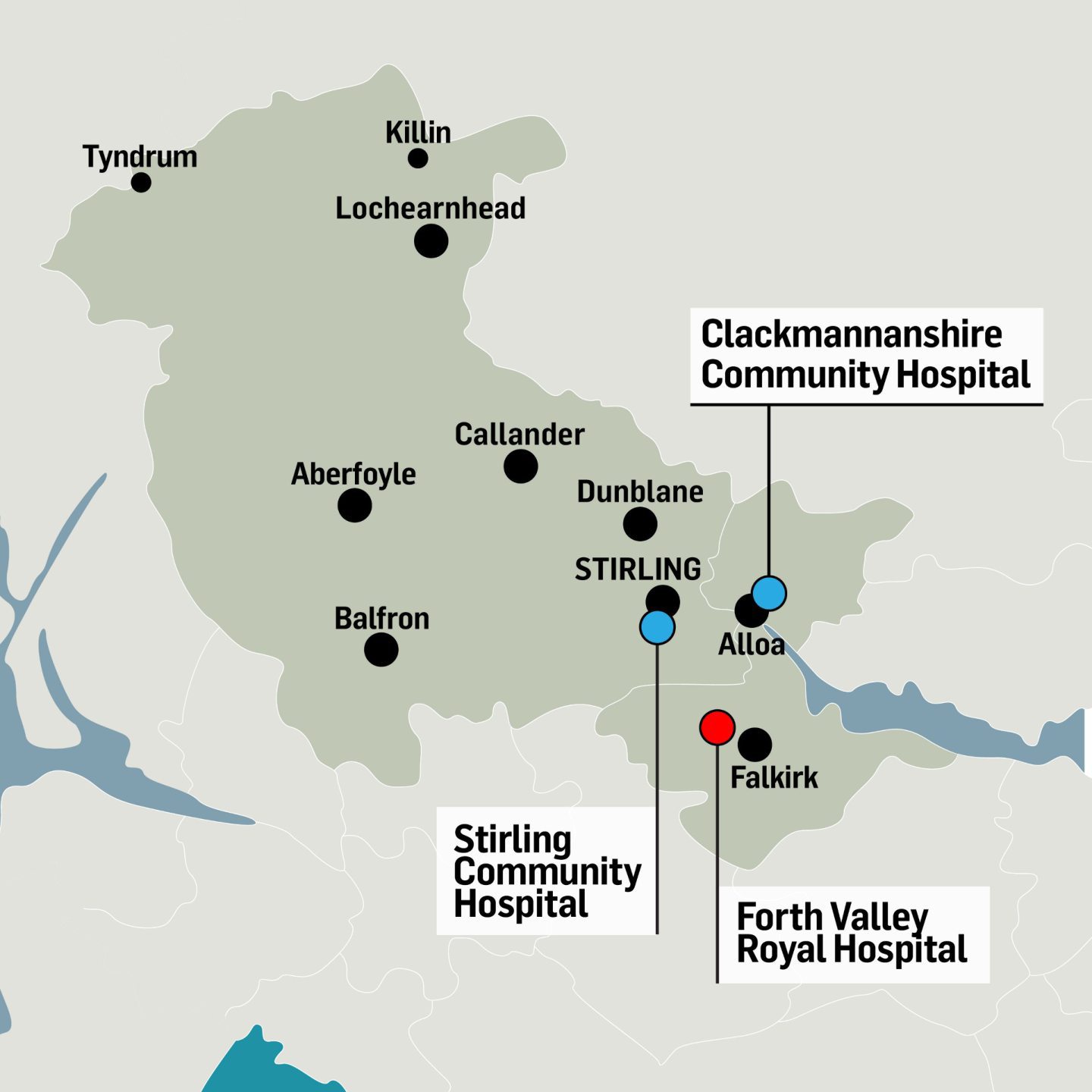Despite a sprawling council area, residents of Stirling and Stirlingshire must travel to Forth Valley Royal Hospital in Larbert to access certain health services.
With an ageing population and thousands of new homes being built in and around Stirling, the pressures on local health services are intensifying, and NHS Forth Valley is deemed one of the worst-performing health boards in Scotland when it comes to emergency care.
Is there a case for a new hospital in Stirling, to serve the city as well as Stirlingshire?
Here, we consider the present, past and possible future of hospital care for Stirling.
What is the current situation with NHS Forth Valley?
More than 306,000 people across Stirling, Falkirk and Clackmannanshire are covered by the NHS Forth Valley health board.
Each region has a small community hospital, but Forth Valley Royal Hospital in Larbert is the main acute hospital for all three council areas.
Community hospital Stirling Health and Care Village provides a range of services, including treatment for minor injuries and GP appointments. It can also give X-rays and provide mental health care.
But acute emergency care, maternity services and children’s services, amongst others, are primarily available at Forth Valley Royal Hospital.
When it opened in 2011, Forth Valley hospital was Scotland’s largest ever NHS construction project.
However, since then it has faced issues, from long accident and emergency (A&E) waiting times to being subject to Scottish Government oversight between November 2022 and October 2024.
According to Scotland-wide data from August 2024, NHS Forth Valley had the lowest percentage of patients seen within the A&E waiting times target.
Just over half (55%) were seen on target. The standard is for 95% of patients to wait no longer than four hours from arrival to admission, discharge or transfer for A&E treatment.
Forth Valley was ranked the lowest for A&E compliance from July 2023 to June 2024.
In July 2024, NHS Lanarkshire dropped slightly lower at 57% within target compared with 57.5% under Forth Valley.
In February of this year, less than half of patients (49%) who presented to A&E at Forth Valley Royal Hospital were seen within the target of four hours.
This was the poorest result since data records began, back in July 2007.
Scottish Green MSP Mark Ruskell, who lives in Lochearnhead, said: “Forth Valley Royal in Larbert has brought many benefits, including a modern maternity unit. Many women felt the old unit at Stirling was very cramped.
“But there have been concerns since before the Larbert hospital was built about the size of the health board area and the need to bring services closer to where people live.
“It makes no sense that patients in Falkirk have to travel to Stirling to access the only minor injuries unit. I suspect that’s why many people head straight to A&E at Larbert, pushing up waiting times.
“For those of us living in the furthest away rural areas, it can be a struggle to access out of hours services, while volunteer groups who take patients to appointments are not properly supported by FVNHS.
“The board really need to look again at how accessible services are. At the moment, rural communities feel like an afterthought.”
Has Stirling ever had its own hospital?
The city did once have its own fully-fledged hospital. Stirling Royal Infirmary, which was replaced by Stirling Community Hospital, opened in 1928.
When Forth Valley Royal Hospital opened, it brought together acute hospital services and provided modern facilities.
But this change has prompted concerns over healthcare provision, such as maternity services.
Roz McCall, MSP for Mid Scotland and Fife, believes localised care is the way forward.
She said: “Cities such as Stirling, and also Dunfermline, have been left as maternity voids where some women in some cases are having to travel over an hour to access maternity services, including whilst in labour.
“It is time we had a serious discussion about local health provision.
“We need to bring back localised maternity care, starting with fully utilising Stirling Community Hospital, to ensure no woman has to endure unnecessary risks just to reach basic healthcare.
“By utilising facilities like those already in our communities, we could not only deliver the care and treatment where it is needed but we would be able to alleviate pressure on over-burdened hospitals like Forth Valley Royal.
“This strategy of centralisation is failing families in the Stirling area, leaving them stranded and unsupported.
“The Scottish Government must face the reality: local women deserve safe, accessible maternity care, not long journeys and empty promises.”
What could happen to Stirling healthcare in the future?
In 2018, it was predicted that the Forth Valley population would increase by around 3.1% or 9,400 people by 2028.
Since then, significant housing developments have been approved.
Durieshill, Stirling’s new village, is expected to house 6,900 people in more than 3,000 homes that are being built over a 30-year period.
The South Stirling Gateway development will see up to 1,100 homes built between Bannockburn and the M9 Pirnhall Junction, where the Corbiewood Stadium was.
Other notable plans include hundreds of new houses and flats at Viewforth and Forthside.
Last year, NHS Forth Valley’s chair blamed the ageing population and demand for treatment for its poor performance.
With an influx in people and a 50% increase in over-60s projected by 2033 across Scotland, health services are certain to face rising pressure.
NHS Forth Valley is confident there will be adequate healthcare provision in the future.
A spokesperson said: “NHS Forth Valley has been working closely with Stirling Council on the plans for these new housing developments for several years.
“As the majority of healthcare is delivered in the community, we are exploring opportunities to create a number of new medical and healthcare centres to help meet the needs of the increased population.
“This includes agreed developer contributions to help cover the cost of building new healthcare facilities.
“A new health and care village has also been developed in Stirling which provides access to a wide range of outpatient clinics, inpatient and rehabilitation services as well as a GP and Minor Injuries Unit.”
The Scottish Government declined to comment further.
- Do you have concerns about healthcare provision in and around Stirling? Get in touch by emailing isla.glen@dcthomson.co.uk
For more Stirling news and features visit our page or join us on Facebook
















Conversation